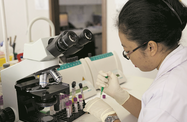
 On the need to develop a manufacturing ecosystem for medical supplies in Myanmar in light of the Covid-19 pandemic
On the need to develop a manufacturing ecosystem for medical supplies in Myanmar in light of the Covid-19 pandemic
How could Myanmar become more self-reliant in medical supplies and equipment?
WIN ZAW AUNG: Myanmar still depends on imports for medical equipment and 99% of medical consumables, including personal protective equipment. As one of Myanmar’s major suppliers of medical equipment and consumables, we were selling these supplies even before the outbreak of Covid-19 and have imported tens of thousands of protective overalls, and millions of face masks, goggles, face shields, air-purifying respirators, surgical gowns and nitrile examination gloves.
However, we do not yet have a manufacturing ecosystem for these supplies in Myanmar. This must be a priority for the future. While it will take some time to develop this, the pandemic is a wake-up call that every country must be self-reliant. In particular, the government needs to devise a national strategy to attract local and international businesses to invest in the manufacturing of medical supplies in Myanmar.
Where can the private sector play a role in strengthening the medical supply ecosystem in Myanmar?
WIN ZAW AUNG: We have been working closely with the Ministry of Health and Sports in the supply chain management of medical equipment and supplies. Our public health system is vast, and there is a large amount of bureaucracy at every level. As a result, supply chain management has not been efficient enough to deliver essential medical supplies to hospitals and health care facilities on time.
We took pre-emptive measures to counteract this, considering both the level of demand during normal periods and the heightened demand during the pandemic. First, we calculated what would be necessary for the diagnosis, prevention and treatment of Covid-19, and then we imported as many medical supplies and equipment into Myanmar as we could – even before the government decided to buy them.
While it was a challenge to bring these supplies into the country, we did so successfully by using air freight, charter cargo and/or land transportation through the borders, and our logistics team ensured that we could deliver the supplies on time, even during the lockdown period.
Since the health crisis began, the government has realised that essential medical equipment and supplies cannot be bought immediately. This has demonstrated the importance of promoting the local manufacturing of medical supplies, which would not require a large amount of investment, nor would it need very sophisticated technologies or skills.
We have been exploring the possibility of establishing a manufacturing facility in Myanmar, and this is now in the pipeline. We built a distribution solutions centre, which opened in March 2019, and reserved around 50% of the land for future manufacturing. We had originally planned to construct this within the next three to five years but, given the current situation, we now recognise the need to do this sooner – and we hope that the government will offer incentives for the local production of essential medical supplies.
Which products do you expect to manufacture at the new manufacturing facility?
WIN ZAW AUNG: We are currently looking to determine a line of products for the domestic market and the export market. First, we need to ensure that we have the right technologies and can source the necessary raw materials from within the country or neighbouring countries, and then we can manufacture the finished products to first serve the domestic market and then to export – particularly outside of Asia.
The primary export markets are likely to be the US, where we have contacts and the majority of our multinational partners are based, and Europe. We may undertake this independently, or we may work with our partners and create a joint venture in Myanmar for the manufacturing arm of the process. With regards to distribution, we are building a different, IT-driven supply chain system.
We have taken advantage of remote working to accelerate the finalisation of our e-commerce platform for medical supplies. The platform is now finished and we hope to launch it by the end of May 2020, having shortened the timeline by around six months. The e-commerce business plan also incorporates our logistics solutions, warehouse management system and enterprise resource planning to create a highly integrated and sophisticated supply chain system.


 On the need to develop a manufacturing ecosystem for medical supplies in Myanmar in light of the Covid-19 pandemic
On the need to develop a manufacturing ecosystem for medical supplies in Myanmar in light of the Covid-19 pandemic